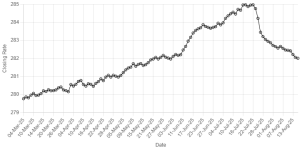China is watching moves by the European Union that could lead to formal curbs on its textile exports, the Commerce Ministry said on Monday. The EU urged China on Sunday to cut its textile exports or face formal curbs on products such as T-shirts and trousers, which have leapt in some cases by more than 500 percent since the end of a global quota system. EU Trade Commissioner Peter Mandelson announced plans for a probe into nine categories of Chinese textile products and such probes.
"We have been watching the EU's moves," said a spokeswoman at the Commerce Ministry. The ministry would issue a statement once the EU introduced formal trade curbs, she said, declining to give specifics.
"There is still room for discussion," she added.
EU governments were divided on how to respond to the surge in cheap Chinese imports with Sweden, Denmark, the Netherlands and Germany cautioning against protectionism.
Major textile producers such as France, Portugal and Italy want the probe to be faster and expanded to as many as 20 product categories.
Chinese textile exporters, meanwhile, are cautious about making long-term commitments for fear curbs could suddenly leave them with excess inventory, industry officials said.
"Because of these worries, Chinese garment makers are mostly signing short-term orders with exporters," said Sun Juan, information department manager for Beijing Cotton Outlook Consulting Ltd.
Under the terms of its entry into the World Trade Organisation (WTO) in 2001, Beijing agreed that members could cap imports of Chinese clothing and textiles at 7.5 percent above the level of shipments the previous year until 2008 - provided they demonstrate that their own firms are suffering.
China made 17 percent of the world's textiles and clothing in 2003, but the WTO sees its market share rising to above 50 percent within the coming three years.
Keen to soothe American concerns that an expected flood of Chinese textiles will swamp the US industry, China's textile industry has pledged to take action if exports to the United States grow too quickly.
"Textile mills are afraid to buy too much cotton, because they are not really sure how much exports will be affected beyond the short-term," said a purchasing manager at a textile mill in Hebei province.
BR100
15,186
Increased By
82.6 (0.55%)
BR30
42,842
Increased By
223 (0.52%)
KSE100
149,361
Increased By
1164.3 (0.79%)
KSE30
45,552
Increased By
281.7 (0.62%)





















Comments
Comments are closed.